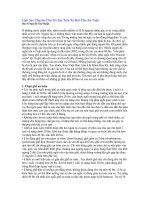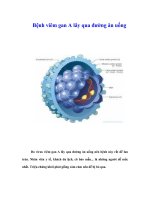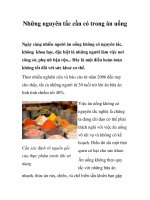Hand-foot-and-mouth disease – An Overview pptx
Bạn đang xem bản rút gọn của tài liệu. Xem và tải ngay bản đầy đủ của tài liệu tại đây (50.15 KB, 5 trang )
e-Journal of the Indian Society of Teledermatology, 2009;Vol 3, No.4 Page
1
Hand-foot-and-mouth disease – An Overview
Prof. Jayakar Thomas, MD., DD., MNAMS., PhD., FAAD.,
Professor & Head,
Department of Skin & STD,
Sree Balaji Medical College, Chennai
INDIA
Address for Correspondence:
Jayakar Thomas,
135, East Mada Church Road,
Royapuram,
Chennai 600013
Email:
Abstract
Hand-foot-and-mouth disease (HFMD) is a viral illness with a distinct clinical
presentation of oral and characteristic distal extremity lesions. Most commonly, the
etiologic agents are coxsackieviruses, members of the Picornaviridae family. HFMD is
more severe in infants and children than adults, but generally, the disease has a mild
course. A brief prodrome of 12-36 hours duration is part of the usual presentation of
HFMD. The lesions on the hands and feet are present for 5-10 days. The mucosal and
cutaneous lesions heal spontaneously in 5-7 days. Usually, no medical care is necessary
for HFMD. The topical application of anesthetics is beneficial. Patient Education
includes good hygiene and avoidance of rupturing blisters.
Introduction
Hand-foot-and-mouth disease (HFMD) is a viral illness with a distinct clinical
presentation of oral and characteristic distal extremity lesions. Most commonly, the
etiologic agents are coxsackieviruses, members of the Picornaviridae family.
Epidemiology and Pathophysiology
Epidemic HFMD viral infections are usually caused by members of the Enterovirus
genus, namely, coxsackievirus A16 or enterovirus 71. In addition, sporadic cases with
coxsackievirus types A4-A7, A9, A10, B1-B3, and B5 have been reported. Infections
usually occur as isolated events, but epidemics occur regularly. The incubation period
averages 3-6 days. Coxsackievirus infection is highly contagious. During epidemics, the
virus is spread by horizontal transmission from child to child and from mother to fetus.
e-Journal of the Indian Society of Teledermatology, 2009;Vol 3, No.4 Page
2
Transmission occurs by means of direct contact with nasal and/or oral secretions, fecal
material, or aerosolized droplets in a fecal-oral or oral-oral route. Initial viral
implantation in the buccal and ileal mucosa is followed by spread to lymph nodes within
24 hours. Viremia rapidly ensues, with spread to the oral mucosa and skin. By day 7,
neutralizing antibody levels increase and the virus is eliminated.
1
Clinical
A brief prodrome of 12-36 hours duration is part of the usual presentation of HFMD,
which consists of the following:
• Low-grade fever with an average temperature of 38.3°C and duration of 2-3
days
• Anorexia
• Malaise
• Abdominal pain
• Sore mouth
• Cough
The enanthem usually precedes the exanthem that is asymptomatic, but both may occur
simultaneously. The lesions on the hands and feet are present for 5-10 days, while the
mucosal and cutaneous lesions heal spontaneously in 5-7 days.
HFMD is more severe in infants and children than adults, but generally, the disease has a
mild course.
• Symptoms such as malaise, low-grade fever, and anorexia are often present.
• Occasionally, children have high fever, marked malaise, diarrhea, and
arthralgias.
• Enteroviral infections may also cause myocarditis, pneumonia,
meningoencephalitis, and even death.
• Infection in the first trimester may lead to spontaneous abortion or
intrauterine growth retardation.
Oral lesions begin as erythematous macules that evolve into 2-3 mm vesicles on an
erythematous base. The vesicles are rarely observed because they rapidly become
ulcerated. They are painful and may interfere with eating. The total number of ulcers
averages 5-10. The vesicles may involve the palate, buccal mucosa, gingiva, and tongue.
The tongue is involved in 44% of the cases, and, in addition to the ulcers, the tongue may
be edematous and tender.
2
e-Journal of the Indian Society of Teledermatology, 2009;Vol 3, No.4 Page
3
Cutaneous lesions are characteristic and are present in two-thirds of patients.
• Typically, the hands, feet, and buttocks are involved.
• The hands are involved more often than the feet, and the dorsal aspect of
the hands and sides of the fingers are more commonly involved than the
palmar surfaces.
• Each lesion begins as a 2-10 mm erythematous macule on which a central,
gray, oval vesicle develops.
• The lesions are characteristically elliptical; their long axis parallels the skin
lines.
• These lesions are asymptomatic and resolve in 3-7 days as a result of fluid
resorption.
A typical cutaneous lesion has an elliptical vesicle surrounded by an erythematous halo.
The long axis of the lesion is oriented along the skin lines.
3
Investigations
Generally, no laboratory studies are necessary for hand-foot-and-mouth disease.
Leukocyte counts are 4000-16,000/µL.
Occasionally, atypical lymphocytes are present.
The virus can be isolated from swabs of the vesicles or mucosal surfaces or from stool
specimens and then inoculated into mice or cultured on viral tissue media. Neutralizing
antibodies rapidly disappear; thus, they are usually detectable only in the acute phase.
High levels of complement-fixing antibodies are present in the convalescent phase.
Studies have illustrated the usefulness of a molecular assay using polymerase chain
reaction primers to arrive at a rapid and specific diagnosis in order to distinguish between
coxsackievirus A16 and enterovirus 71.
7
This may hold promise in future outbreaks
because infections with enterovirus 71 tend to be associated with more severe
complications and fatalities. Classic histopathology findings of hand-foot-and-mouth
disease include an intra-epidermal vesicle that contains neutrophils and eosinophilic
cellular debris. The adjacent epidermis has reticular degeneration, that is, intercellular
and intracellular edema. The dermis has a mixed infiltrate. Eosinophilic intranuclear
inclusions are observed with electron microscopic studies.
4
Neuropathology in fatal cases of enterovirus 71 infection have shown features of an acute
encephalitis involving the brain stem and spinal cord.
5
Complications
• Dehydration occasionally occurs in children with hand-foot-and-mouth disease.
• Rarely, complications of hand-foot-and-mouth disease include
meningoencephalitis, myocarditis, pulmonary edema, and death.
e-Journal of the Indian Society of Teledermatology, 2009;Vol 3, No.4 Page
4
Prognosis
• The prognosis for hand-foot-and-mouth disease is excellent; except in large
epidemics caused by human enterovirus 71 in which neurologic complications and
death have been reported, especially in children.
Treatment
Usually, no medical care is necessary for hand-foot-and-mouth disease. The topical
application of anesthetics is beneficial. Viscous lidocaine or diphenhydramine may be
used to treat painful oral ulcers. Antipyretics may be used to manage fever, and
analgesics may be used to treat arthralgias.
6
Low-level laser therapy has also been shown
to shorten the duration of painful oral ulcers.
7
Patient Education
• The virus that causes hand-foot-and-mouth disease may be present in the patient's
stool for 1 month.
• The patient’s exclusion from school is generally not required.
• Good hand-washing technique is necessary to reduce the potential spread of
disease.
• To reduce viral spreading, the blisters should not be ruptured.
Points to remember
Hand-foot-and-mouth disease (HFMD) is a viral illness with a distinct clinical
presentation of oral and characteristic distal extremity lesions.
Most commonly, the etiologic agents are coxsackieviruses, members of the
Picornaviridae family.
HFMD is more severe in infants and children than adults, but generally, the disease has a
mild course.
A brief prodrome of 12-36 hours duration is part of the usual presentation of HFMD. The
lesions on the hands and feet are present for 5-10 days.
The mucosal and cutaneous lesions heal spontaneously in 5-7 days.
Usually, no medical care is necessary for HFMD. The topical application of anesthetics is
beneficial.
Patient Education includes good hygiene and avoidance of rupturing blisters.
e-Journal of the Indian Society of Teledermatology, 2009;Vol 3, No.4 Page
5
References
1. Chang LY, King CC, Hsu KH, et al. Risk factors of enterovirus 71 infection and
associated hand, foot, and mouth disease/herpangina in children during an
epidemic in Taiwan. Pediatrics. Jun 2002; 109(6):e88.
2. Thomas I, Janniger CK. Hand, foot, and mouth disease. Cutis. Nov 1993;
52(5):265-6.
3. Adams SP. Dermacase. Hand-foot-and-mouth disease. Can Fam
Physician. May 1998; 44:985, 993.
4. Tsao KC, Chang PY, Ning HC, et al. Use of molecular assay in diagnosis of hand,
foot and mouth disease caused by enterovirus 71 or coxsackievirus A 16. J Virol
Methods. Apr 2002;102(1-2):9-14
5. McMinn P, Stratov I, Nagarajan L, Davis S. Neurological manifestations of
enterovirus 71 infection in children during an outbreak of hand, foot, and mouth
disease in Western Australia. Clin Infect Dis. Jan 15 2001; 32(2):236-42.
6. Hurwitz S. The exanthematous diseases of childhood. In: Hurwitz, ed. Clinical
Pediatric Dermatology: A Textbook of Skin Disorders of Childhood and
Adolescence. 2
nd
ed. Philadelphia, Pa: WB Saunders; 1993:359-61.
7. Toida M, Watanabe F, Goto K, Shibata T. Usefulness of low-level laser for
control of painful stomatitis in patients with hand-foot-and-mouth disease. J Clin
Laser Med Surg. Dec 2003; 21(6):363-7.









